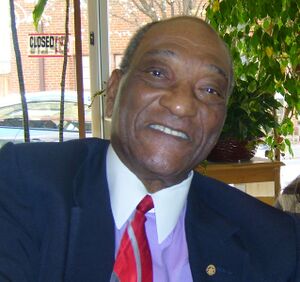Edward Perkins
 | |
| Born | June 8, 1928 Sterlington, Ouachita Parish, Louisiana, USA |
| Died | 7 November 2020 (Age 92) |
| Alma mater | University of Maryland University College, University of Southern California |
| Spouse | Lucy Chen-mei Liu |
| Member of | Council on Foreign Relations/Members 3 |
Edward Joseph Perkins was an American career diplomat who was U.S. Ambassador to Liberia, South Africa, the United Nations, and Australia. He also worked as the director of the United States State Department's Diplomatic Corps.[1][2]
He was appointed Deputy Chief of Mission of the U.S. Embassy in Monrovia, Liberia in 1981, at a time when the US heavily supported the dictator Samuel Doe after he came to power in a 1980 CIA-backed coup.[3]
Background and education
Perkins was born in Sterlington, Louisiana. He grew up in Pine Bluff, Arkansas. There he attended a school for blacks, separated by race, consisting of only two classrooms. He moved to Portland, Oregon, and graduated from Jefferson High School in 1947. The same year, he entered the US Army. He did his military service in the US Army and in the United States Marine Corps. In total, he served three years in the US Army and four years in the United States Marine Corps. During this time, he was stationed in South Korea and Tokyo with the US Army Quartermaster Corps, which was also separated by race.
After the end of his military service, in 1953 he enrolled at Lewis & Clark College, a private college in Portland, where he stayed for a year. He received a Bachelor of Arts degree from the University College of the University of Maryland in 1967. He graduated from the University of Southern California in 1972 with a Master of Arts in Public Administration. In 1978 he obtained his Ph.D. (Doctor of Public Administration) in Public Administration.
Career
Perkins' professional career began with the US Army. In 1958, he became Chief of Personnel at the Army & Air Force Exchange Service in Taipei, Taiwan. From 1962 to 1966, he was first Deputy Chief and later Chief of Personnel and Administration at the Army and Air Force Exchange Service in Okinawa. In 1967 he was Assistant General Services Officer at the U.S. Operations Mission to Thailand.
In 1972 he entered the diplomatic service. In the same year, he was assigned to the Office of the Director General of the United States Foreign Service as a staff assistant. From 1972 to 1974, he was assigned to the State Department's Bureau of Personnel as a personnel officer. From 1974 to 1975 he worked at the Bureau of Far East and South Asian Affairs and from 1975 to 1978 at the Office of Management Operation. In 1978 he moved to the U.S. Embassy in Accra, Ghana as Counselor for Political Affairs. Perkins was appointed Deputy Chief of Mission of the U.S. Embassy in Monrovia, Liberia in 1981 and was Director of the Department of State's Office of West African Affairs of the State Department from 1983 to 1985.
He was appointed Ambassador to Liberia in 1985. He took office during the presidency of Samuel K. Doe, who since 1984 had increasingly lost US support, due to his incompetent and corrupt rule. According to his own statements, Perkins saw his task as continuing to secure Liberia as an ally of the United States and, in the sense of American foreign policy in West Africa, to keep the country functioning.[4]
As the US ambassador, Perkins was responsible on the one hand for pushing economic reforms and democratization in Liberia; on the other hand, he had to ensure the protection of the considerable strategic and technical facilities that the US maintained in Liberia. When Perkins and his staff arrived in the Liberian capital Monrovia, their main task was to convince Samuel K. Doe not to run for president in the 1985 elections. Perkins used financial leverage to do this; he promised that if Doe was elected, the United States and other states would cease their technical and military assistance to the country, despite their interests in Liberia.[5]
In 1986 he became ambassador to apartheid South Africa, appointed by Ronald Reagan, where he remained until 1989. He met with bourgeois representatives of the black opposition in Soweto, with religious leaders in Mamelodi and political activists in the squatter camps of Cape Town. He organized art exhibitions in Pretoria, where black and white artists exhibited together and were also invited to the exhibition openings together.
After his return, he again worked in the State Department until 1992. From 1989 to 1992, he was the Director General of the Foreign Service of the United States and the Director of Personnel in the Department of State. In 1992 he was appointed Ambassador to the United Nations. In this capacity, he was also the representative of the United States to the UN Security Council.[6]
In 1993, Perkins became the US ambassador to Australia, where he remained until 1996. On the occasion of the appointment, Perkins received permission from then-President Bill Clinton, since he was already over 65 years old.[7] He then retired from the United States Foreign Service with the rank of Career Ambassador.
He has taught at the University of Oklahoma, where he is Senior Vice Provost Emeritus of International Programs at the International Program Center and Professor Emeritus of the School of International and Area Studies. He is a member of the American Academy of Diplomacy.
References
- ↑ https://afsa.org/pioneer-bridge-builder-and-statesman-conversation-ambassador-edward-j-perkins
- ↑ https://web.archive.org/web/20100625123244/http://nafsa.org/_/File/_/jan08_voices.pdf
- ↑ https://web.archive.org/web/20081010215622/http://thenews.com.lr/story.php?record_id=3722&sub=News
- ↑ https://web.archive.org/web/20110124213327/http://www.pbs.org/newshour/bb/africa/july-dec03/liberia_8-06.html
- ↑ http://www.answers.com/topic/edward-perkins
- ↑ http://history.state.gov/